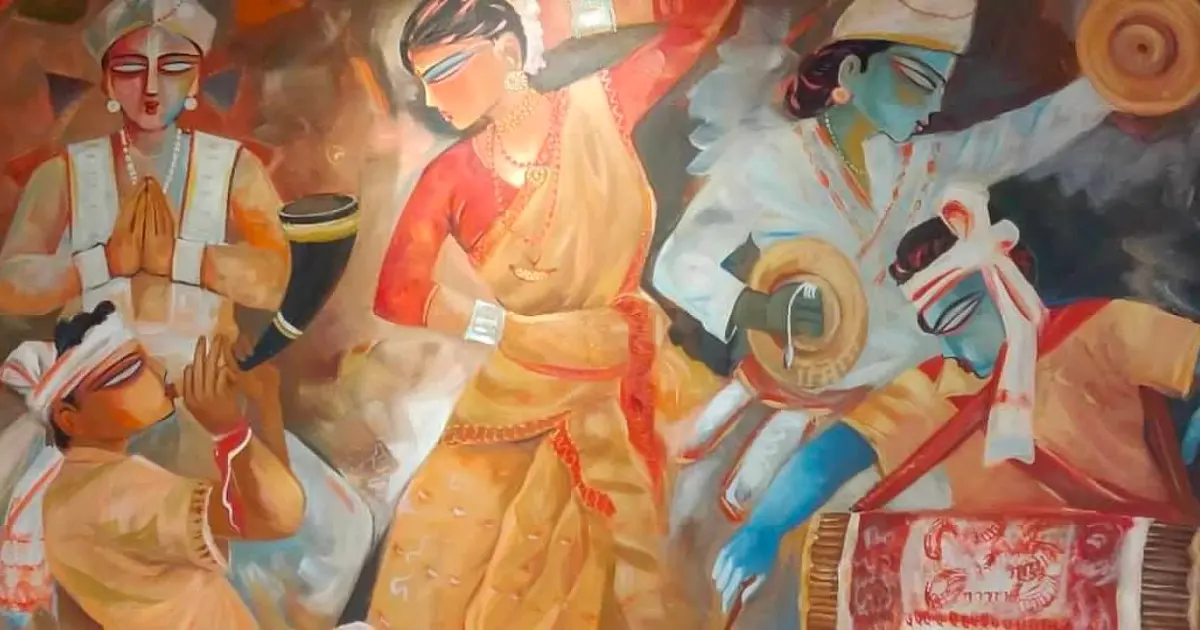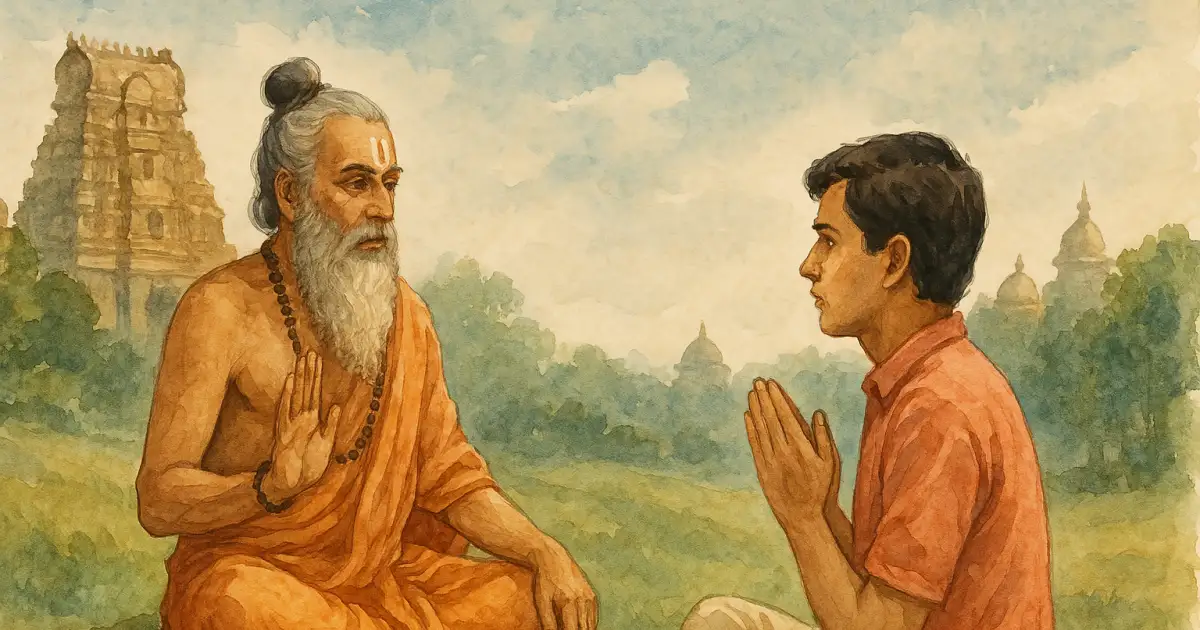The worship of Devī Lakṣmī and Gaṇeśa Bhagavān is conducted in every home for auspiciousness, blessings, and prosperity. It is an all-encompassing feeling of being enveloped by the divine, bringing forth pure bliss and peace.
Tithi
Dīpāvali is celebrated on the amāvāsyā of the kṛṣṇa pakṣa (waning moon) of the Kārttika month. In India, Dīpāvali is a five-day celebration commencing with Dhanteras on the 13th (trayodaśī) lunar day and ending with Bhāī Dūja on the 2nd (dvitīyā) lunar day of the same month in the śukla pakṣa (waxing phase).
- 13th (Trayodaśī) kṛṣṇa pakṣa: Dhanteras / Dhanatrayodaśī / Yama-dīpam
- 14th (Caturdaśī) kṛṣṇa pakṣa: Naraka-Caturdaśī / Choti Dīpāvali
-
Amāvāsyā: Dīpāvali
- 1st (Pratipadā) śukla pakṣa: Govardhana Pūjā
- 2nd (Dvitīyā) śukla pakṣa: Bhāī Dūja / Bhau Beej
Day-wise Current Celebrations of the Five Days of Dīpāvali:
Day 1: Kārttika Kṛṣṇa Trayodaśī — Dhanteras / Dhanatrayodaśī / Yama-dīpam
“Dhana” means wealth; “Teras/Trayodaśī” is the thirteenth lunar day.
- It is believed Śrī Lakṣmī emerged from the Samudra-manthana (as mentioned in Skanda Purāṇa, Kārttika-māsa-māhātmya), hence linked to the month of Kārttika.
- Considered auspicious to buy gold/silver jewelry, automobiles, utensils, property, etc.
- Homes are cleaned and whitewashed to welcome Devī Lakṣmī; raṅgavallī and Lakṣmī’s footprints are drawn at the entrance.
- Lamps are lit all night in her honor; Lakṣmī-pūjā is performed with flowers, fruits, and sweets.
- Some people observe a fast, breaking it after sunset with pañcāmṛta prasāda.
- A dīpa made of wheat-flour, filled with tila (sesame) oil and placed facing south, is lit to please Yama-rāja, as it is believed to ward off untimely death.
Day 2: Kārttika Kṛṣṇa Caturdaśī — Choti Dīpāvali / Naraka-Caturdaśī / Kālī Chaudasa
- Skanda Purāṇa (Kārttika-māsa-māhātmya) says those who offer lamps to Yama on the fourteenth day of the dark fortnight in Kārttika-māsa relieve their forefathers from naraka.
- Pre-sunrise abhyaṅga (a full body and head massage) with tila-taila, followed by ubtana (udvartana) and bath, is said to ward off negative energies and untimely death.
- Sweet dishes are prepared; homes are lit in the evening (lamps with mustard/tila oil or ghee); Lakṣmī is worshipped.
Regional Notes:
- Goa: Effigies of Narakāsura are burnt in the morning; lamps line the home; a specific berry is crushed underfoot to symbolize annihilation of evil.
- West Bengal (Bhūta-Caturdaśī): Fourteen dīpas are lit in dark corners of the house to guide visiting ancestral spirits; special pūjās are performed for Yama, Kālī, Kṛṣṇa, Śiva, Hanumān, Viṣṇu.
- Tamil Nadu: The ritual bath is done pre-sunrise; celebrated as Dīpāvali, marking Kṛṣṇa-Satyabhāmā’s victory over Narakāsura (also called Dīpāvali Bhogī). Some families perform Lakṣmī-pūjā on this day.
- Karnataka: Dīpāvali is celebrated as Kṛṣṇa’s victory; festivities extend till Bali Pāḍyami (fourth day).
- Gujarat: Many worship Hanumān for protection from roaming spirits.
Mahāvidyās and Their Corresponding Rātri (per Svatantra-tantra, Śaiva text):
- Śoḍaśī – Divya-rātri
- Bhuvaneśvarī – Siddha-rātri
- Chinnamastā – Vīra-rātri
- Bhairavī – Kāla-rātri
- Dhūmāvatī – Dāruṇa-rātri
- Bagalāmukhī – Vīra-rātri
- Mātaṅgī – Moha-rātri
- Tārā – Krodha-rātri
- Kamala / Mahākālī / Mahārātrī – Mahā-rātri
Kāla-rātri (dīpānvitā caturdaśī and amāvāsyā) is especially dear to Kālī and Tārā; hence, Kālī-pūjā is performed in Bengal on these nights.
Day 3: Amāvāsyā — Dīpāvali / Lakṣmī–Gaṇeśa-pūja / Kālī-pūjā
- Main celebration day: ritual bath in the morning; visiting friends and family; exchanging gifts and sweets.
- Evening, Lakṣmī–Gaṇeśa-pūjā is performed for peace and prosperity; homes glow with rows of dīpas.
- Bengal: Kālī-pūjā coincides with Dīpāvali, connected to Skanda Purāṇa (Kārttika-māsa-māhātmya) passages on the release of Kālī and other goddesses from Bali’s prison; there are also mentions of Mahārātri on kṛṣṇa caturdaśī.
- Jainism: Mark the day as Mahāvīra’s nirvāṇa; also the Jain new year.
Day 4: Govardhana Pūjā / Annakūṭa / Bali Pratipadā / (Gujarat New Year)
- Gujarat: Annakūṭa / Govardhana Pūjā, where a mountain of vegetarian food is offered to Kṛṣṇa (honoring the lifting of Govardhana).
- Known as Nūtana Varṣa / Bestū Varṣa (linked to King Vikramāditya’s new era).
- Essential items (e.g., salt, sugar) are purchased; temple visits and prayers to Kṛṣṇa.
- Bali Pratipadā: Celebrated in parts of India, marking the notional return of daitya-rājā Bali to earth.
Day 5: Bhāī Dūja / Bhaubeeja / Viśvakarmā-pūjā
- Brothers visit sisters; sisters apply tilaka, perform āratī, and feed them the first meal; brothers then give gifts to sisters.
- Also called Yama-dvitīyā, commemorating Yama’s visit to his sister Yamī (also called Yamunā), bringing joy to souls in Yama-loka.
Legends Associated with Dīpāvali
1. Return of Śrī Rāma to Ayodhyā (often cited but not supported with evidence from any of our scriptures).
2. Defeat of Narakāsura (often cited but not supported with evidence from any of our scriptures).
3. Bali rules the earth for three days starting from Dīpāvali.
4. Devī Lakṣmī emerges from Samudra-manthana.
5. Pāṇḍavas return to Hastināpura on Kārttika amāvāsyā after exile (Mahābhārata).
6. Kālī-pūjā (Kālikula Śāktism) venerating Kamala-ātmikā and other Śaktis.
7. New Year in Gujarat and some northern communities.
8. Viṣṇu rescues Lakṣmī from King Bali’s prison.
Scriptural Basis and Prescribed Rituals:
Bhaviṣya Purāṇa — Dīpamālikotsava
Śrī Kṛṣṇa said: On the nights of Kārttika amāvāsyā, daityas make ample efforts to return all over the earth.
Rituals advised:
Bathe with apāmārga (Achyranthes aspera) by circling the leaves above the head while reciting the mantra for the removal of pāpa:
हर पापमपामार्ग भ्राम्यमाणं पुनः पुनः। आपदं किल्विषं चापि ममापहर सर्वशः । अपामार्गं नमस्तेऽस्तु शरीरं मम शोधय ॥
“O apāmārga, take away the pāpa that is wandering around me again and again. Remove from me all my troubles and pāpa. O apāmārga, I offer my obeisances unto you. Please purify my body.”
Invoke Yama in his epithets (Yama, Dharmarāja, Mṛtyu, Vaivasvata, Antaka, Kāla, Sarvabhūtakṣaya). At pradoṣa, light lamps in temples (Śiva, Viṣṇu, Brahmā), warehouses, caitya, assembly halls, riverbanks, palaces, ponds, gardens, vāpī, roads, workshops, and stables.
Perform Pārvaṇa-śrāddha on amāvāsyā; gift food and dakṣiṇā to brāhmaṇas. A royal proclamation honors Bali; the city is decorated; processions, songs, and dances ensue.
Women winnow at midnight to drive away Alakṣmī; widespread dīpa-donations remove fear of naraka.
Rituals of Mārgapālī (road-protectress of kuśa and kāśa grass), worship of Bali and Vindhyāvalī, and public festivities through the night are observed. People pray with this mantra:
बलिराज नमस्तुभ्यं विरोचनसुत प्रभो। भविष्येन्द्रसुराराते पूजेयं प्रतिगृह्यताम् ||
“O King Bali, salutations to you, O glorious son of Virocana.
O future Indra, O adversary of the devas, kindly accept this worship.”
Śrī Viṣṇu was pleased with Bali, and in return for his generosity, granted him this amāvāsyā tithi of Kārttika māsam. Since then, the tradition of this Kaumudī utsava has continued.
The Kaumudī-utsava (earthly joy) grants prosperity and removes obstacles; one should remain cheerful, as the mood is said to set the tone for the year. It is said that whatever feeling a person experiences on this Kaumudī tithi remains the same throughout the year.
Therefore, one should remain cheerful and happy on this date. This date is Vaiṣṇavī, and also ancestral. The person who worships Rājā Bali with devotion on the day of Dīpamālā spends the whole year happily, and all his wishes are fulfilled.
Skanda Purāṇa — The Freeing of the Devas and Devīs
On this sacred day, the devas, along with devīs Sarasvatī, Kālī, Gaurī, and Lakṣmī, were released from the prison of Bali. These goddesses should be worshipped with offerings and services, and Lakṣmī’s feet are to be devoutly massaged in reverence.
After their release, the devas went to the Kṣīra Sāgara with Lakṣmī and rested there. Hence, devotees are instructed to prepare fine cots woven with twine, soft cotton beds, and sheets white like milk and foam. The devas and Lakṣmī should be installed in the proper directions with vaidika chants. Freed from fear of daityas, Lakṣmī herself slept peacefully in the lotus, and so arrangements for her rest must also be made at home.
Whoever prepares a bed of lotuses for Lakṣmī on this day ensures her happiness, and she will not leave their house. But those who neglect these amenities risk sleepless nights filled with financial worries. Therefore, Lakṣmī should be worshipped with all care and effort.
Description of Celebrations from Trayodaśī to Dīpāvali
- Trayodaśī (Kārttika Kṛṣṇa Trayodaśī)
Brahmā says: On this day, one should bathe in the morning, observe the Trirātri-vrata, and prepare for Govinda worship and the Govardhanotsava. If the tithi extends beyond three muhūrtas, it remains valid. At pradoṣa, offering a dīpa and naivedya to Yama destroys the fear of untimely death.
Yama himself taught that placing a lamp at one’s doorway with the mantra:
मृत्युना पाशदण्डाभ्यां कालेन च मया सह । त्रयोदश्यां दीपदानात् सूर्यजः प्रीयतामिति ॥
“May the son of the Sun (Yama) be pleased along with Mṛtyu (god of Death), along with noose and rod, Kāla, as well as Mā (Lakṣmī) be pleased, because a lamp has been offered on the trayodaśī day.”
- Caturdaśī (Naraka-Caturdaśī)
On this day, Lakṣmī dwells in oil and Gaṅgā in water. Bathing early in the morning with apāmārga (Achyranthes aspera) and prapunnāṭa (Cassia tora) leaves removes the fear of naraka. The mantra should be said thrice while rotating the leaves three times around the head:
सीतालोष्ठसमायुक्त सकण्टकदलान्वित। हर पापमपामार्गं ्राम्यमाणः पुनः पुनः॥
“O apāmārga, endowed with thorny leaves and soil, dispel pāpa as you are whirled again and again”
After bathing, one offers a lamp to the two divine dogs Śyāma and Śabala, sons of Mṛtyu, with the prayer that they be pleased. At that time, this mantra is to be recited:
शुनको श्यामशवलौ भ्रातरौ यमसेवकोौ । तुष्टौ स्यातां चतुर्दश्यां दीपदानेन मृत्युजौ ॥
“The two canine brothers Śyāma and Śabala are the sons of Mṛtyu and attendants of Yama. May they be pleased by this offering of lamp on the caturdaśī day.”
Then follows tarpaṇa for the fourteen Yamas (Yama, Dharmarāja, Mṛtyu, Antaka, Vaivasvata, Kāla, Sarvabhūtakṣaya, Audumbara, Dadhna, Nīla, Parameṣṭhin, Vṛkodara, Citra, Citragupta). Each name is invoked thrice with sesame-water offerings. Because Yama is both god and ancestor, even those whose fathers live may perform this tarpaṇa.
यमाय धर्मराजाय मृत्यवे चान्तकाय च। वैवस्वताय कालाय सर्वभूतक्षयाय च॥
ओदुम्बराय दध्नाय नीलाय परमेष्ठिने। वृकोदराय चित्राय चित्रगुप्ताय ते नमः॥
एकैकस्य-त्रीसित्रजन दधज्जला´जलीन। यावज्जन्मकृतम पापम, तत्क्षणा देव नश्यति॥
“Obeisance to you, to Yama, to Dharmarāja, to Mṛtyu, to Antaka, to Vaivasvata, to Kāla, to Sarvabhūtakṣaya (destroyer of all living beings), to Audumbara, to Dadhna, to Nīla, to Parameṣṭhin, to Vṛkodara, to Citra, to Citragupta.”
These are fourteen name-mantras. Add the word ‘Namah’ to each of the name mantras at the end and say each mantra aloud thrice, while offering sesame seeds mixed with water three times.
If caturdaśī coincides with amāvāsyā and Svāti nakṣatra, Dīpāvali is observed that day.
King Bali’s Boon
Once, Bali requested from Viṣṇu (as Vāmana) that for three days each year, beginning on caturdaśī, his kingdom remain on earth, and Lakṣmī dwell in the homes of those who light lamps. Viṣṇu granted it. Thus, the three-day Dīpāvali festival began, with special honor to Śakti on caturdaśī night when Mahārātrikā appeared. Ancestors are guided with torches (ulkā) during these nights when the Sun is in Libra.
- Amāvāsyā (Main Dīpāvali Day)
On amāvāsyā morning, devotees bathe, worship gods and ancestors, and perform Pārvaṇa-śrāddha with curd, milk, and ghee. Except for children and the sick, all fast until evening. At pradoṣa, Lakṣmī is worshipped with a bed of lotuses prepared for her rest. Milk is cooked with spices, sugar, and camphor, made into laddus, and offered.
She is praised as:
त्वं ज्योतिः श्रीरवीन्द्वग्निविद्युत्सौवर्णतारकाः ।
सर्वेषां ज्योतिषां ज्योतिर्दीपज्योतिःस्थिते नमः ॥ ८९ ॥
या लक्ष्मीर्दिवसे पुण्ये दीपावल्यां च भूतले ।
गवां गोष्ठे तु कार्तिक्यां सा लक्ष्मीर्वरदा मम ॥ ९० ॥
“O Mahālakṣmī seated in the flame of the lamp, you are the radiance of all lights — sun, moon, fire, gold, and stars. On this holy Dīpāvali day, may the Lakṣmī shining in homes and cowsheds ever bless me.”
Thereafter, lamps are donated according to capacity: arranged in temples, and placed at crossroads, cremation grounds, riverbanks, mountains, houses, under trees, in cowsheds, plantations, and homes. Feeding brāhmaṇas and the needy precedes donning new clothes and ornaments before eating. The “five gates of naraka”—violence against animals, alcohol, incest, theft, and betrayal—must be avoided. At midnight, devotees stroll through the streets to witness the city’s festive splendor before returning home.
Padma Purāṇa — Dīpāvali Observances
1. Bhagavat Pūjan, Dīpa-dāna, and Yama-tarpaṇa
Mahādeva tells Kārttikeya that ancestors constantly long for a virtuous son who satisfies Śrī Keśava by offering lamps in the Kārttika month. A lamp lit with ghee or sesame oil before Viṣṇu equals the merit of an Aśvamedha sacrifice and bathing in all tīrthas. The five days from kṛṣṇa trayodaśī to śukla dvitīyā are supremely sacred; donations made during this period are imperishable and fulfill all desires. Hence, lamps should be lit each evening in homes, cowsheds, beneath sacred trees, and in temples, cremation grounds, and riverbanks. Even pāpi ancestors are released through the virtue of these offerings.
Śrī Kṛṣṇa instructs that six lamps should be lit outside the house in Yama’s name during Kārttika kṛṣṇa-pakṣa, ensuring protection from untimely death. While doing so, one should pray that Yama, Mṛtyu, Kāla, and Lakṣmī be pleased.
2. Naraka-Caturdaśī
Those fearing naraka should bathe at moonrise using apāmārga, gourd, cakramarda, and kaṭphala leaves, circling them on the head with the prayer: “O apāmārga, remove my pāpa as I turn you again and again.”
After this, Yama is worshipped by reciting his many names (Yama, Dharmarāja, Mṛtyu, Antaka, Vaivasvata, Kāla, Sarvabhūtakṣaya, Audumbara, Dadhna, Nīla, Parameṣṭhin, Vṛkodara, Citra, Citragupta).
यमाय नमः, धर्मराजाय नमः, मृत्यवे नमः, अन्तक्राय नमः, वैवस्वताय नमः, कालाय नमः, सर्वभूतक्षयाय नमः, ओदुम्बराय नम दक्नाय नमः, नील्याय नमः, परमेष्ठिने नमः, वृकोदराय नम चित्राय नमः, चित्रगुप्राय नमः।
One should donate dīpas after worshipping the devas. After this, beautiful dīpas should be lit at different places at the beginning of the night. Dīpas should be lit in Brahmā, Viṣṇu, and Śiva temples, in secret houses, under deva-vṛkṣas, in sabhā-maṇḍapas, on the banks of nadīs, on boundary walls, in gardens, on the banks of baolī, in udyānas, in home gardens, and also in secluded aśva-śālās and go-śālās.
3. Amāvāsyā — Dīpāvali
On amāvāsyā, after bathing and worshipping gods and ancestors with Pārvaṇa-śrāddha, brāhmaṇas are fed and propitiated. Women awaken Lakṣmī at Brahma-muhūrta to ensure prosperity. At prātaḥkāla, Govardhana is worshipped; cows and bulls are decorated but not yoked or milked. The prayer to Govardhana asks blessings for protection, removal of pāpa, and constant presence of cows before, behind, and within one’s heart.
After worship, pray to Govardhan like this:
गोवर्धन धराधार गोकुलत्राणकारक ॥ विष्णुबाहुकृतोच्छय गवां कोटिभ्रदो भव । या लश्मीर्लोकपाल्वानां धेनुरूपेण संस्थिता ॥ घृते वहति यज्ञे मम॒ पापं व्यपोहतु । अग्रतः सन्तु मे गावो गावो मे सन्तु पृष्ठतः । गावो मे हदये सन्तु गवां मध्ये वसाम्यहम् ॥
“Govardhana, who wears Pṛthvī! You are Gokula’s protector. Lord Śrī Kṛṣṇa lifted you in his arms. May you grant me millions of blessings. Lakṣmī of the Lokapālas, who is present in the form of cows and provides all the offerings for the yajña, may she remove my pāpa. May there be cows in front of me, may there be cows behind me too, may the cows reside in my heart, and may I also reside amidst the cows.”
4. Śukla Dvitīyā — Yamadvitīyā
On this day, Yama once visited his sister Yamunā, who received him with great hospitality. Pleased, he granted happiness to the souls in Yama-loka, who were freed from torment and celebrated the event. From then on, the day was called Yamadvitīyā. Therefore, brothers visit sisters, eat food prepared by them, and offer them gifts of gold, ornaments, and clothes. Even eating a sister’s meal brings strength and averts hardship for a year.
Mahābhārata Reference
In the Udyoga-parva (Bhagavat-yāna parva, section LXXXIII), Śrī Kṛṣṇa sets out on Kaumudī Kārttika (the day of Dīpāvali) as an envoy of peace to the Kauravas at the end of the Pāṇḍavas’ exile. The negotiations continued until Kārttika Pūrṇimā, when both sides prepared for war. This implies that the five-day Dīpāvali period coincided with the end of the exile.
5. Dhanteras (Dhantrayodaśī)
Dhanteras is observed on the thirteenth day (trayodaśī) of the bright fortnight (śukla pakṣa) of Kārttika. The word “dhana” means wealth or prosperity; hence, it is the “Blessed Thirteenth.”
-
Jain tradition: It marks the day of Lord Mahāvīra’s mokṣa.
-
Swaminarayan sect: Devotees clean and polish Śrī Kṛṣṇa’s jewelry as sevā.
-
Hindu tradition: Widely celebrated as a day of wealth, believed to be when Goddess Lakṣmī and her brother Dhanvantari, the God of Āyurveda, emerged during the Samudra-manthana.
The Padma Purāṇa narrates that on ekādaśī the poison Kālakūṭa appeared, followed by Alakṣmī. On dvādaśī, Dhanvantari arose with the nectar, and Lakṣmī also appeared, radiant and auspicious. The Moon and tulasī also emerged, and the gods, pleased, recited the Śrī-sūkta in her praise, to which Lakṣmī granted blessings.
Alongside Lakṣmī, Kubera—the Lord of Wealth—is also worshipped. A tale in the Padma Purāṇa (Uttara-khaṇḍa) tells of Dhaneshwara, a merchant in Vārāṇasī, who gained great merit by serving devotees observing the Kārttika vrata. Upon death, Yama could not touch him, and he was taken instead to serve Kubera in Yakṣa-loka. This perhaps underlies the custom of buying valuables on this day, symbolizing the arrival of Lakṣmī into one’s home. Thus, homes are cleaned, lamps lit, and gold, silver, or other precious goods purchased—acts believed to bring fortune throughout the year.
Akṣaya Tṛtīyā
Akṣaya Tṛtīyā is celebrated on the third day (tṛtīyā) of the bright fortnight (śukla pakṣa) of the Vaiśākha month.
According to the Skanda Purāṇa (23.7, Akṣaya Tṛtīyā Māhātmya), whoever fasts on this day with Viṣṇu in mind attains imperishable merit; if the day coincides with the Kṛttikā constellation, its sanctity is multiplied. It pleases ancestors and ensures the eternal fruits of good deeds performed on this day.
Traditionally, people purchase jewelry, utensils, and make new investments, as such acts are believed to yield unending prosperity. Charity and almsgiving on this day are especially meritorious. Families also worship Viṣṇu and Lakṣmī at home and visit temples, ensuring that the blessings of akṣaya (imperishability) remain with them for the year ahead.
6. Prabodhinī (Devotthāna) Ekādaśī
Observed on the eleventh day of the bright fortnight (śukla pakṣa) in the month of Kārttika, Prabodhinī Ekādaśī marks the awakening of Lord Viṣṇu from his four-month cāturmāsya sleep. It is a supremely sacred day, as described in the Padma Purāṇa (Uttara-khaṇḍa, ch. 61). Ritual observances destroy pāpa, increase religious merit, and grant salvation to the devout.
7. Dev-Dīpāvali (Kārttika Pūrṇimā)
According to the Skanda Purāṇa (ch. 35, section 4), the Tripurā utsav (festival) is celebrated on the full-moon day of Kārttika. On this day, lamps must be lit in Śiva temples. The daitya Tripura, empowered by Brahmā’s boon that no deva, asura, or human could kill him, roamed in a celestial chariot crafted by Viśvakarmā. When he tormented the three worlds, Śiva was invoked, and the Lord destroyed Tripura with a single arrow on this very full moon. All the devas offered dīpas to Śiva in gratitude.
Offering lamps on this day, especially seven hundred and twenty wicks, liberates one from pāpa. A mantra prescribed prays that beings of land, water, and air be freed from rebirth, and even the lowest-born attain brāhmaṇa-hood on beholding the lamps. The Tripurā festival is thus to be celebrated at dusk, with rituals of lamp-lighting and devotion. One who beholds the Lord on this day, particularly when conjoined with the Kṛttikā constellation, becomes a wealthy brāhmaṇa, master of the Vedas, for seven births. Performing the Vṛṣotsarga (releasing a bull to wander freely) at night leads the devotee to Śiva’s city.
In present times, this day is celebrated as Kārttika Pūrṇimā / Dev-Dīpāvali in Varanasi. The ghats are illuminated with countless earthen lamps, commemorating Śiva’s victory over Tripurāsura and joining in the gods’ cosmic rejoicing.
Importance of Tulasī, Tulasī-Vivāha, and Śālagrāma Worship
तुलसीदलानि पुष्पाणि ये यच्छन्ति जनार्दने ।
कार्तिके सकलं वत्स पापं जन्मायुतं दहेत् ॥ ६१ ॥
दृष्टा स्पृष्टाथ वा ध्यान्ता कीर्तिता नामतस्तु सा ।
रोपिता सिंचिता नित्यं पूजिता तुलसी शुभा ॥ ६२ ॥
नवधा तुलसीभक्तिं ये कुर्वन्ति दिने दिने ।
युगकोटिसहस्राणि तन्वन्ति सुकृतं मुने ॥ ६३ ॥
यावच्छाखाप्रशाखाभिर्बीजपुष्पदलैर्मुने ।
रोपिता तुलसी पुंभिर्वर्धते वसुधातले ॥ ६४ ॥
तेषां वंशे तु ये जाता ये भविष्यन्ति ये गताः ।
आकल्पवर्षसाहस्रं तेषां वासो हरेर्गृहे ॥ ६५ ॥
यत्फलं सर्वपुष्पेषु सर्वपत्रेषु नारद ।
तुलसीदलेन चैकेन कार्तिके प्राप्यते तु तत् ॥ ६६ ॥
संप्राप्तं कार्तिकं दृष्ट्वा नियमेन जनार्दनः ।
पूजनीयः महाविष्णुः कोमलैस्तुलसीदलैः ॥ ६७ ॥
इष्ट्वा क्रतुषतैर्देवान्दत्त्वा दानान्यनेकशः ।
तुलसीदलैस्तत्पुण्यं कार्तिके केशवार्चने ॥ ६८ ॥
“O child, even pāpa of countless lives are destroyed by offering tulasī-leaves and flowers to Viṣṇu in Kārttika. Tulasī is auspicious when seen, touched, meditated upon, described, praised, planted, sprinkled, or worshipped; devotion in these nine ways brings merit for aeons. As long as a planted tulasī grows with branches, twigs, flowers, and seeds, all born in that family dwell in Viṣṇu’s abode till the cosmic dissolution. The fruit of all flowers and leaves is obtained by offering a single tulasī-leaf in Kārttika. Thus, Viṣṇu must be worshipped with tender leaves. The merit equals hundreds of sacrifices and countless gifts.” - Padma Purāṇa: Section 6 - Uttara-Khaṇḍa - Chapter 61 - Prabodhinī Ekādaśī
Once, due to Durvāsā’s curse, Indra lost his prosperity, and the gods churned the ocean with the asuras. From it arose Airāvata, the Kalpa tree, the Moon, Lakṣmī, Uccaiḥśravas, Kaustubha, Dhanvantari with nectar, and divine medicinal plants. Tears of joy from Viṣṇu (as Dhanvantari) fell into the nectar and became the tulasī plant. Lakṣmī was also born, and the gods gave Lakṣmī and tulasī to Hari, who accepted them. Hence, tulasī is most dear to Viṣṇu and is worshipped by all devas.
From the seeds, three plants appeared: Dhātrī, Mālatī, and Tulasī, embodying tamas, sattva, and rajas. Manifesting as women, they enchanted Viṣṇu, especially Vṛndā (Tulasī). Tulasī and Dhātrī offered love. Pleased, Viṣṇu took Tulasī and Dhātrī with him to Vaikuṇṭha. Thus, in the Kārttika-vrata, Viṣṇu is worshipped at the root of the tulasī plant.
A house with a tulasī grove is a tīrtha where Yama’s servants do not enter. Those who grow tulasī, destroyer of all pāpa and fulfiller of desires, never meet Yama. Seeing Narmadā, bathing in Gaṅgā, and living near the tulasī plant are equally meritorious. Planting, guarding, and worshipping her burns all pāpa of thought, word, and deed. One who worships Hari and Hara with tulasī leaves never takes birth again and attains liberation.
All tīrthas, including Puṣkara, all rivers, including Gaṅgā, and all gods, including Vāsudeva, dwell on a single tulasī leaf. Even Yama cannot approach one who dies with tulasī, no matter how pāpi he is. - (Skanda Purāṇa, Kārttika-māsa-māhātmya, Chapter 8 - The Greatness of Tulasī (Basil Plant))
Tulasī Vivāha - Skanda Purāṇa, Kārttika-māsa-māhātmya - Chapter 31 - The Rite of Kūṣmāṇḍa-navamī
The marriage of the tulasī plant should be celebrated according to one’s vaidika tradition; doing so grants the great merit of giving away a maiden in marriage. On the ninth day of the bright fortnight of Kārttika, one should prepare a golden image of Hari along with tulasī, worship it with devotion and sense-restraint, and observe a three-day vrata culminating in navamī (extended to midday if it overlaps aṣṭamī).
If dhātrī and aśvattha trees are planted together and this festival is celebrated, its merit endures for countless kalpas. In ancient times, Kiśorikā, daughter of Kanaka, performed tulasī’s wedding with devotion in the evening, freeing herself from the stigma of widowhood; thus, the rite is to be performed in the evening.
This marriage ceremony is to be observed annually by all Vaiṣṇavas, following the prescribed procedure along with its ancillary details.
Śālagrāma - Skanda Purāṇa, Kārttika-māsa-māhātmya - Chapter 2 - Rites to be Observed in Kārttika
Hari is ever-present in the circular marks of the Śālagrāma stone, and it must always be worshipped. If one gifts a Śālagrāma during the month of Kārttika, even Viṣṇu cannot measure the merit gained. To present it to a brāhmaṇa well-versed in the Vedas after due worship yields immense fruits equal to gifting land stretching as far as the seven oceans.
A story tells of a brāhmaṇa woman who became a widow five days after marriage; by gifting a Śālagrāma in Kārttika, she revived her husband. Thus, in this sacred month, the gift of a Śālagrāma after a holy bath and worship is supremely meritorious and beyond doubt.
Conclusion
Dīpāvali is far more than a festival of lights: it connects us to ancestors, seeks longevity and well-being, strengthens family and social bonds, dispels negative energies, and invokes peace, prosperity, protection, and blessings from the divine. It honors wealth and auspicious beginnings through Lakṣmī in all her forms, celebrates Earth’s renewed fertility after monsoons, affirms the victory of dharma over adharma, and—most poignantly—guides ancestral souls toward higher realms through dīpa-dāna across these five sacred days from Kārttika kṛṣṇa trayodaśī to śukla dvitīyā.
References:
-
Chapter 8 - The Greatness of Tulasī (Basil Plant)
-
Dhanteras 2024: Rituals traditions celebrations across India and what to buy this year on the auspicious occassion
-
Yama Deepam 2023 Date, Time, and Significance
-
Chapter 59 - Narakāsura slain—The Pārijāta tree brought to Dvārakā
-
https://www.wisdomlib.org/hinduism/book/the-skanda-purana/d/doc371650.html#note-t-139433
-
Narak Chaturdashi 2025: The Day To Get Blessings Of Krishna, Kali and Satyabhama
-
Here’s how South India celebrates Narak Chaturdashi
-
Bhoot Chaturdashi 2022: All you need to know about Bengal's 'Halloween day' – Firstpost
-
Kali Puja 2021: Celebrating Shakti and the victory of good over evil – Firstpost
-
In which scriptures can we find the original stories of the Mahavidyas? - Hinduism Stack Exchange
-
Deepavali | Festivals & Events | Tamil Nadu Tourism
-
Diwali Festival in Karnataka: Diwalifestival.org
-
2022 Hanuman Puja date and time during Diwali for New Delhi, NCT, India
-
Diwali 2023: 7 important traditional customs that are followed during the festival of lights - Hindustan Times
-
https://indianexpress.com/article/research/diwali-special-decoding-the-many-forms-of-goddess-kali-in-india-5436248/
-
Chapter 62 - The Practice of Mahāvidyā
-
Diwali | Melbourne Shwetambar Jain Sangh Inc.
-
Worshiping Govardhana Hill
-
Lord Kṛṣṇa Lifts Govardhana Hill
-
https://vedabase.io/en/library/sb/10/25/advanced-view/
-
Annakut - Kalupur Mandir
-
Diwali Padwa, Bali Pratipada: See significance and date - The Economic Times
-
Diwali 2024 calendar: When is Diwali, Choti Diwali, Bhai Dooj? Check out the dates for 5 days of Festival of Lights | Hindustan Times
-
2024 Yama Dwitiya Date and Time during Diwali for New Delhi, NCT, India.
- https://archive.org/details/bhavishya-puran-gita-press-gorakhpur/page/n560/mode/1up
-
19. Classification of Sraddhas
-
Diwali Rituals: दीपावली पर निभाई जानेवाली अनोखी परंपराएं
-
https://www.wisdomlib.org/hinduism/book/the-skanda-purana/d/doc371651.html#note-e-139440
-
What is Kaumudi Mahotsav? | Diwali Festival
-
https://www.wisdomlib.org/hinduism/book/the-skanda-purana/d/doc371650.html#note-t-139433
-
https://www.wisdomlib.org/definition/yama#text1_1
-
Diwali 2024 to be celebrated on Nov 1: Six-day long festival this year
-
Sangava, Saṃgāva, Samgava, Saṅgava, Shangava: 11 definitions
-
https://archive.org/details/skanda-puran-gita-press-gorakhpur/page/n449/mode/1up?view=theater
-
https://archive.org/details/padma-puran-gita-press-gorakhpur/page/n799/mode/2up?view=theater
-
Section LXXXIII [Mahabharata, English]
-
Dating the Mahabharata war – A tale of eclipses, archaeology, and genealogies - Hindustan Times
-
Dhanteras, Dhana-terasa, Dhanaterasa: 6 definitions
-
Chapter 9 - The Churning Starts
-
https://pujayagna.com/blogs/hindu-festivals/dhanteras-festival?srsltid=AfmBOoo9sgZmurrTDnb4Qs_bsDxwNoDR0HshD7YX4tu8AeXMsA6hHVFn
-
https://www.wisdomlib.org/hinduism/book/the-skanda-purana/d/doc371725.html
-
When is Akshaya Tritiya 2024? Date, Story, History, Significance and all you need to Know about Akshaya Tritiya - Times of India
-
Chapter 35 - Vaikuntha Caturdaśī Vrata
-
Dev Diwali 2024 | Dev Deepavali Date, Significance, Celebration.
-
Chapter 61 - Prabodhinī Ekādaśī
-
Chapter 8 - The Greatness of Tulasī (Basil Plant)
-
Chapter 23 - The Origin of Dhātrī and Tulasī
-
Chapter 31 - The Rite of Kūṣmāṇḍa-navamī
-
Chapter 2 - Rites to Be Observed in Kārttika
- Naraka-chaturdaśī & Dīpāvali: Origin and significance - Rishihood University, Delhi NCR
-
Naraka Chaturdashi And Dipavali | Dr Srinivasa Jammalamadaka






